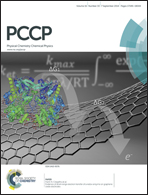A DFT study on the interaction between glycine molecules/radicals and the (8, 0) SiCNT†
Abstract
The geometrical structures, energetics and electronic properties of glycine molecules as well as dehydrogenated radical interaction with silicon carbide nanotubes (SiCNTs) are investigated based on density functional theory (DFT) for the first time. Different from the weak adsorption on CNTs, it is shown that glycine molecules tend to be chemisorbed onto SiCNTs. There are three patterns of the individual glycine molecule adsorbed on the (8, 0) SiCNT, including monodentate, cycloaddition and dissociative ones, with the latter two patterns (Eads ranges from −22.08 to −34.99 kcal mol−1) more stable than the monodentate one (Eads ranges from −8.16 to −21.14 kcal mol−1). In addition, we also investigated the adsorption of multiple glycine molecules on various zigzag (n, 0) (n = 7, 8, 9 and 10) SiCNTs. It is shown that totally n (n = 7, 8, 9 and 10) molecules can be chemisorbed on one circle of the wall of the SiCNT at most. And the Eads per glycine decreases gradually with the increasing tube diameter due to the curvature effects. For the adsorption of dehydrogenated glycine radicals, it is found that both the N-centered and C-centered ones can form stable complexes by attacking the (8, 0) SiCNT. Totally one monodentate and two bidentate adsorption configurations of the N-centered radical and three monodentate configurations of the C-centered one can be found. Note that the important half-metals can be obtained for the bidentate configurations from the N-centered radical due to the hybridization state of the radical and the tube in one spin channel crossing the Fermi level, while the p-type semiconductor can be produced for the monodentate configurations from the C-centered radical because the impurity state derived from the radical itself is closer to the edge of the valence band above the Fermi level, which may be applied in building electronic devices and metal-free catalysis. Finally, we found that the encapsulation of the glycine molecule is exothermic and thus energetically favourable in the SiCNTs with the diameter larger than the (9, 0) SiCNT. The present study is expected to create promising applications in nano-device building and biotechnology.


 Please wait while we load your content...
Please wait while we load your content...